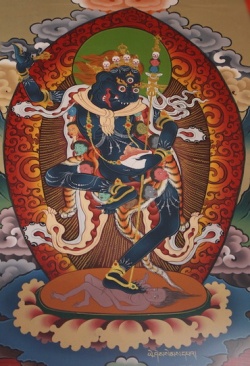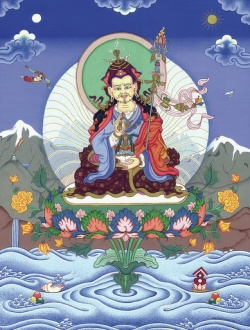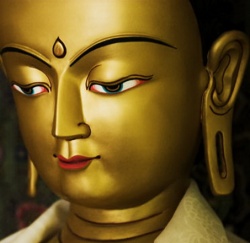Emptiness & the object of negation
Transforming the heart
Emptiness & the object of negation
Geshe Jampa Tegchok
Transforming the Heart: The Buddhist Way to Joy and Courage, by Geshe Jampa Tegchok, Ex Abbot of Sera Je Monastery, is a commentary on The Thirty-seven Practices of Bodhisattvas by Gyalsay Togme Sangpo. Studied by followers of all schools of Tibetan Buddhism, the root text gives, in 37 short verses, the essential practices leading to enlightenment.
In the late 1980's Geshe Jampa Tegchok, who was then Abbot at Nalanda Monastery in France, gave this extraordinary commentary. He clearly explains the meditation of exchanging oneself with others for developing love and compassion for all living beings. He lays open the methods for doing glance, stabilizing, and analytical meditation and offers an in-depth discussion on the nature of emptiness – all the essentials for transforming our heart and developing joy and courage in our practice are included in this book. Here are various excerpts from the chapter on emptiness.
Ultimate bodhicitta refers to the wisdom realizing emptiness. Emptiness is regarded as the "ultimate" object, not because it is some sort of absolute truth that is independent of everything else. Rather, emptiness of inherent existence is the ultimate or deepest way in which all phenomena exist. Developing the wisdom realizing emptiness involves looking beyond superficial and deceptive conventional appearances.
Whatever appears is your own mind;
Your mind from the start was free from fabricated extremes.
Understanding this, do not take to mind
(Inherent) signs of subject and object –
This is the practice of Bodhisattvas.
... In exploring the emptiness of inherent existence of phenomena, we are focusing on the ultimate truth, the deepest mode of existence of persons and phenomena. The persons and phenomena themselves are conventional truths, dependently existing things that appear with their own characteristics and perform various functions in the world. These two truths are related in that conventional truths are what appear to our mind on a day-to-day basis, while ultimate truths are their deeper mode of existence.
Nothing can ever be found that is self-existent or that exists by itself independently of other phenomena. Whatever appears to the mind, both inner objects related to sentient beings' minds and outer objects in the environment, is merely labeled by mind. If we analyze the final mode of existence of the subject – the mind which labels – we find it too is free from elaborations of the two extremes of true existence and total non-existence. Thus the final way of existing of both object and subject is that they do not exist from their own side. They are like space, which in this context is defined as a mere lack of tangibility and obstruction. Wherever we look in space, we never find anything tangible or any impediment. Similarly, if we look for existence from its own side in any phenomenon, we never find it. We simply find freedom from the elaborations of the two extremes.
How meditating on emptiness destroys our suffering:
When we understand the evolution of our unsatisfactory experiences in cyclic existence, we will see that meditating on emptiness is their antidote. All knowable things – people and phenomena – appear to our minds to be inherently existent. We then grasp at them as existing inherently. Our inappropriate attention focuses on them, and that gives rise to the various disturbing attitudes of anger, attachment, and so on. These disturbing attitudes motivate our actions, which in turn leave karmic imprints on our mind-streams. When these imprints ripen, we meet with suffering. Let's look at this process in more depth and see how meditating on emptiness stops this process.
... Whether an object appears attractive or ugly to us, ignorance, a mind which conceives of it as existing from its own side, will arise in us. After that, but before either attachment or aversion arise towards the object, there will be a conceptual consciousness called "inappropriate attention." If a pleasing object is slightly beautiful, inappropriate attention exaggerates, makes it much more beautiful, and thinks, "This is really good!" This inappropriate attention induces attachment, a mind of desire that thinks, "If only I could have that." If anger is going to be produced, first there is inappropriate attention, which exaggerates the unpleasant aspect of the object, making it more negative. As a result, we then get angry and want to destroy or run away from what we think is harming us.
Attachment, anger, and other disturbing attitudes motivate us to say and do various things, and thus we accumulate negative karma or actions. As a result we experience their results, feelings of suffering. Ignorance is also behind our experiences of happiness in cyclic existence. For example, ignorance grasping at a truly existent I arises, and we think, "I want to create good karma so I'll be happy in the future!" This thought is a form of attachment, which clings to just our own happiness within cyclic existence, and is also a disturbing attitude. With such a motivation, we create positive karma, which leaves the imprints in our mind-streams that will ripen into our future experiences of happiness. Although this is a good motivation compared to the previous ones, it nevertheless does not free us from cyclic existence because it still thinks all phenomena exist inherently.
Identifying ignorance:
The great masters stress that at the beginning it is very important to identify ignorance. Once we work out what it is, we will be able to understand what to do to eliminate it. If we dismiss this step, our understanding will remain superficial. When we want to realize selflessness, we have to know clearly what the object of negation is. Often we think we already understand what ignorance is and what the object of negation in the emptiness meditation is. Having only looked superficially, we consider it easy and go ahead. Of course nothing good comes of this. Seeing this danger, the past masters emphasized the importance of identifying ignorance and the object of negation. If we have clearly identified these, we will not have difficulty in realizing emptiness. Having difficulty in understanding emptiness is due to not identifying the object of negation properly.
Ignorance believes the object of negation actually exists. If we want to attain liberation, we need to abandon samsara, and to do that we have to abandon its root. Therefore, we have to identify that root, which is ignorance. What is this ignorance? How does it apprehend its object? Thinking like this is the best of meditations. This is what people who want to reach liberation or enlightenment need to think about.
... Ignorance is the discordant class, which is contradictory to the wisdom realizing selflessness. That means it is exactly the opposite of this wisdom. It is not just a lack of, or non-existence of this wisdom; nor is it just something other than that wisdom. In this context, this wisdom is the concordant class.
Ignorance is not this wisdom, therefore it is in the discordant class. Moreover, ignorance is contradictory to the wisdom so it is the contradictory discordant class of that wisdom.
If ignorance is the exact opposite of the wisdom realizing selflessness, we need to know what that wisdom apprehends and what is contradictory with that. What that wisdom apprehends, that is, its object of the mode of apprehension, is selflessness.
The object of the mode of apprehension (dzin btangs kyi yul is synonymous with the engaged object (jug yul) of that mind, that is, the main object with which that mind is concerned.
For example, in the case of the wisdom realizing emptiness, the main object with which it is concerned is emptiness, non-true existence.
The wisdom realizing emptiness apprehends a lack of existence from its own side.
The contradictory discordant class, the opposite of this lack of existence from its own side, is true existence.
Apprehending true existence means apprehending something as existing without depending on causes, conditions, or any other factors. The main object with which ignorance is concerned is a truly existent one, and this kind of object does not exist at all.
Self-grasping ignorance is a mind that apprehends existence from its own side, so we can see that it is exactly contradictory with the wisdom realizing selflessness.
The word "self" has different meanings in different situations. In the terms "self-grasping ignorance" or "selflessness," it means inherent existence and can refer to the inherent existence of any object. When the word "self" is used to mean person or I, then it refers to the conventionally existent person. There are two forms of self-grasping ignorance (here "self" means inherent existence): the ignorance which is the self-grasping of persons and the ignorance which is self-grasping of phenomena. There are two forms of selflessness: the selflessness of persons and the selflessness of phenomena, and so there are two wisdoms realizing selflessness: one realizing the selflessness of persons and one realizing the selflessness of phenomena. Thus, there are two ignorances exactly contradictory with those: the ignorance which is self-grasping of persons, and the ignorance which is self-grasping of phenomena. Both of these ignorances are incorrect minds, because they superimpose true existence where there is none.
The self-grasping of persons and of phenomena are differentiated only in terms of their focal object (dmig yul). They are the same in apprehending, or grasping, self-existenceThey are the same in subtlety. However, one grasps at the inherent existence of persons, the other at the inherent existence of phenomena other than persons, for example, the aggregates or things in the environment.
To realize emptiness, we have to realize the non-existence of the referent object (zhen yul) of the ignorance, which is the root of cyclic existence. This is an inborn or innate self-grasping, not one which is intellectually acquired. Innate self-grasping ignorance thinks phenomena exist from their own side, and it is unmixed with reasons learned in philosophical study. It is an ignorance, which emerges spontaneously, without our having to learn it or put effort into making it arise. Birds and other creatures have it in their continuums too. They also wander in cyclic existence, and this same ignorance grasping at self-existence arises in them spontaneously. Their thought of things existing truly, obviously is not connected with any reasons. They are not able to think in that way. Intellectually acquired self-grasping also holds things to exist from their own side, but it has faulty reasons and proofs learnt through studying a mistaken philosophy. Only the innate ignorance is the root of cyclic existence. When we first realize emptiness directly, we eradicate only intellectually acquired self-grasping. By familiarizing ourselves with emptiness, our realization increases in strength and gradually eradicates the innate ignorance. Thus, innate grasping at true existence can still occur in the mind of a person who has realized emptiness directly, although it is not very strong.
What is the object of negation?
What is the object of negation, true existence? Meditators who have realized emptiness say it is exactly what we see with our eyes. In the case of the cup, for example, what appears to us is a truly existent cup. The cup appears as if it were truly existent. It is said, "Leave the vivid appearance as it is." That means it is exactly that vivid appearance right in front of us, which is the appearance of true existence. We should not put this vivid appearance aside and look elsewhere for the object of negation. The table itself is not the object of negation, but the vivid appearance right in front of us of a truly existent table is. This is a delicate issue; we cannot put the vivid appearance of the cup aside and look elsewhere for the object of negation. Nor can we say that the cup is to be negated. It is just the vivid appearance of its true existence, which is.
Avoiding the two extremes:
When working out what selflessness is, we have to negate the object of negation, self-existence. In doing so, we must avoid two faults: negating too much and negating too little. Our degree of negation has to be exactly right. Negating too much, means negating something, which should not be negated along with that which should. This error leads us to the extreme of nihilism or total non-existence. If we have not negated all that should be negated, something remains and we fall to the extreme of eternalism or permanence. When meditating on selflessness we have to negate self-existence, no more and no less.
For example, when we are negating the object of negation, true existence, if we also negate the general, conventional existence of the object, we are negating too much. If we eliminate conventional existence as an object of mind, then we eliminate something that exists, and we will have no basis on which to speak of karma and its results and of what to practice and what to avoid.
We will be unable to talk of the four truths, the twelve links, refuge, and so on because we will think that they do not exist. If we negate the existence of conventional objects, we will not be able to contemplate the path which combines method and wisdom, and in that case we will not be able to attain the union of the two bodies (Sanskrit: kaya) of a Buddha. In fact, we will not even be able to say, "I go to the store," because we will think that no person exists at all, that there is no store, and there is no action of going. Clearly, negating too much is a big mistake. This could happen if, when we meditate and conclude that there is no true existence, we negate too much and also think there is no existence of anything whatsoever.
When we contemplate the emptiness of inherent existence, we should think that if something inherently existed, it would exist without depending on any causes, conditions, parts, designating concept or name. In that case, if we were to search for or investigate the basis of designation, we would have to be able to find something, which we could point out as this independent thing.
The basis of designation is the parts or attributes upon which something is labeled. For example, the basis of designation of the person is his or her aggregates of body and mind, and the designated object is the person. If the person existed from its own side, if it were truly existent, established without depending on causes, conditions, or anything, then if we were to search among the aggregates for such a person, we would have to find it. Yet such a thing is not to be found.
The mind which thinks of non-true existence does not itself have to think that the person exists conventionally, that it is established by valid cognition, and so on. That is to say, the investigating mind, which is a mind analyzing the ultimate, does not have to think about how the conventional functioning of things works. A mind analyzing the ultimate focuses only on the non-existence of a truly existent person. It does not have to think that a conventional person exists.
However, if a person who meditates on the ultimate nature, emptiness, emerges from her meditative equipoise into the subsequent attainment, and at that time is not able to posit cause and effect or dependent arising, that is the fault of negating too much. In the time of subsequent attainment, he or she should know how to posit the stages of the path of the vast, conventional side with valid cognition and to avoid negating its existence. A person is able to do this because she has valid cognizers in her continuum realizing conventional phenomena and these phenomena are established by conventional valid cognition.
To put it simply: phenomena do not exist ultimately, but do exist conventionally. Even though we negate ultimate existence, we need to know how to posit conventional existence. For example, the parts of the clock – the face, the battery, the back, the knobs and so forth – are called the basis of designation of the clock. The clock is the object designated upon that basis. The clock, which is designated in dependence upon its basis, exists. However, if we search for a truly existent clock that exists from its own side independently of everything else, we cannot find it. H
owever when the clock appears to our mind, it appears as if it existed from its own side, independently of all else. Certainly, when we think about it we see that it exists through relying on causes, conditions, and so on, because we can see that it was made by someone. But when we see the clock, it appears to exist from its own side, as does everything else around us. Just as it appears that way, so does our mind automatically apprehend or grasp the object to exist from its own side.
The mind, which apprehends it as existing from its own side, is called the innate true grasping, i.e., the innate conception of true existence. If the clock did exist in the way that it appears, then we should be able to find it when we look in its basis of designation. But if we search in the basis of designation – the parts – to see whether there is an object existing from its own side or not, we don't find it. That is negating its existence from its own side. But if we also negate the fact that it does exist in general, that is too extensive. The clock does exist; if we do not analyze, we see it performs a function, specifically that of telling time.
All phenomena have some unique function that they can perform when we do not analyze and look for their ultimate existence. If we analyze the basis of designation and search for what it is that performs the function, we cannot find it. For example, when we think about the selflessness of the person, we have to refute self-existence based on the person. But when we are refuting that, if we negate the person itself, something which does the actions of being produced and ceasing, coming and going, and so on, our negation is too extensive.







